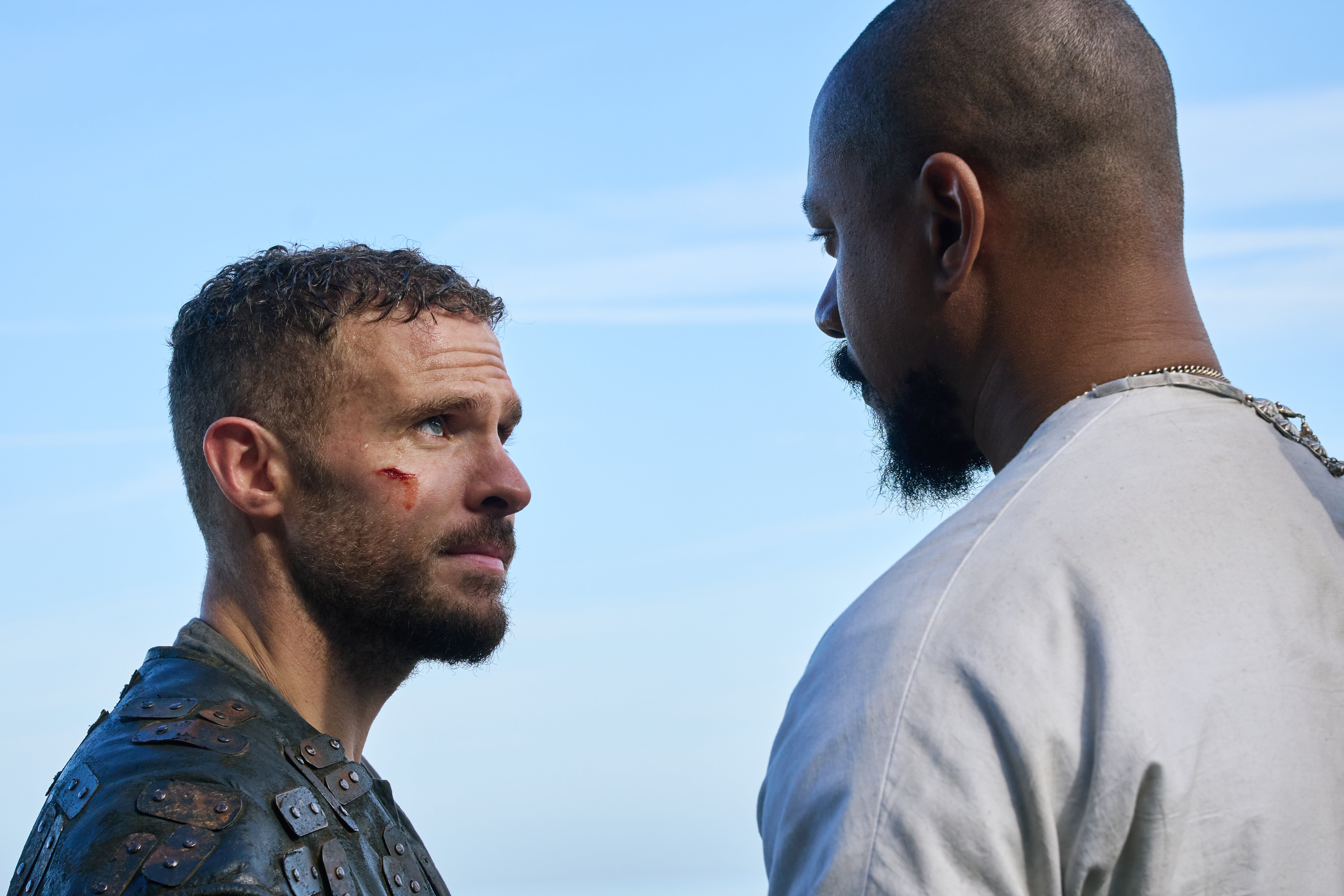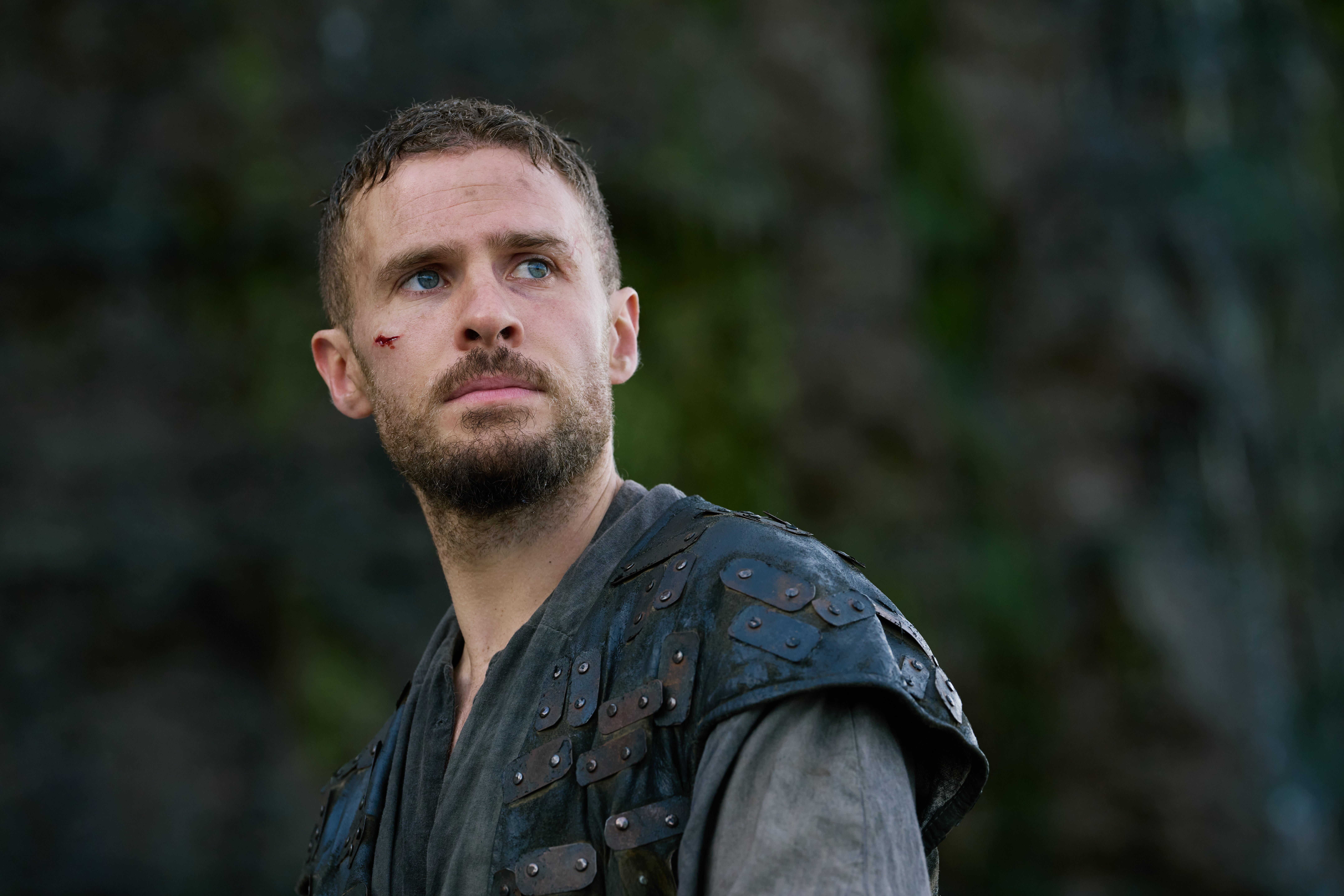The Winter King gives us a King Arthur for our times – dark, gloomy and violent
Every age reinvents Arthur in its own image and ITV’s adaptation of Bernard Cornwell’s full-blooded warrior has little truck with courtly love and the Holy Grail, finds Ed Power

The Winter King is coming. ITV’s big end-of-year drama is a dank, doomy take on the legend of King Arthur, adapted from Bernard Cornwell’s Warlord novels. The 10-part series stars Marvel’s Agents of S.H.I.E.L.D.’s Iain De Caestecker as the illegitimate warrior son of Eddie Marsan’s Uther Pendragon – a sweary bruiser trying to unite Britain’s tribes against the invading Saxons and also not a great dad. Packed with gore-strewn battlefields and sweary anti-heroes, it makes Game of Thrones look like CBeebies Storytime.
Cornwell’s Warlord Chronicles are deliciously gritty. Yet The Winter King has its distinct sense of onrushing calamity and panic – one that feels plugged into contemporary social and political anxieties. It would be a stretch to say cost of living woes or climate change angst have directly inspired De Caestecker’s modern take on an ancient character. Even so, someone watching 20 years hence will immediately recognise this Arthur as the product of uncertain times.
But then, that’s always been true of King Arthur. Every new telling of his story is a product of its era. From the 12th-century writings of Geoffrey of Monmouth through the 15th-century tales of Thomas Malory’s Le Morte d’Arthur to contemporary movies such as John Boorman’s Excalibur (the prog rock of Arthurian tales), Guy Ritchie’s King Arthur (the Marvel movie of Arthurian tales)… up to The Winter King, Britain’s ancient regent is forever speaking to the present day. Even Monty Python and the Holy Grail was suffused with Seventies gloom.
“There’s a good reason that [the] story has endured in Western culture for generations,” Winter King executive producer Julie Gardner told the official series podcast recently.
“It’s got everything: it’s the classic, how do you live, who are you as a human? What are you prepared to sacrifice: honour, love, ambition? How do you live up to your mistakes?” The tale accrues new cultural reference points over the centuries, she believes, from “the soap opera of everyday life” to “Shakespearean themes of what it is to be a king, a ruler”. And “that melting pot of theme makes it as vibrant and relevant today as it would be through all the generations.”
She’s right: whatever the state of the world, there has always been an Arthur to match. The Victorians thrilled to Malory’s stiff-upper-lipped hero. The 1980s kicked off with Boorman’s post-hippy weirdo. In 2021, arthouse studio A24 and director David Lowery gave us Arthur (Sean Harris) as an “alien-like” mentor to Dev Patel’s Sir Galahad in the creepy and otherworldly The Green Knight – a project dripping with lockdown claustrophobia.
“Arthur always looms large because his myth is about leadership and power,” Sarah Peverley, a medievalist, cultural historian and English professor at the University of Liverpool, explains.
“It harks back to a lost golden age that never really existed, but which each generation feels they have lost. The behaviour of Arthur and his knights prompts us to ask questions about what the perfect society looks like and what makes a good leader – or a bad one.”

The King of Camelot – on screen, in video games and the printed page – has always been whoever we need him to be. That goes back to the 1100s when Welsh monk Geoffrey of Monmouth wrote the first definitive account of the Arthur myth with his History of the Kings of Britain: one of the “must reads” of its day. It was largely a work of fiction: for instance, he cheekily incorporated into Arthur’s story Merlin the magician, a composite character composed from earlier figures with no connection to Camelot.
The real Arthur is believed to have been a Romano-British warlord who led resistance against the Anglo-Saxon invaders of Britain in the fifth century. Six hundred years later, in Geoffrey’s day, Britain was under Norman rule. The island’s new overlords were drawn to the idea of a figure from antiquity who happened to be a sworn foe of their enemy, the Anglo-Saxons.
“You’re in the 1130s. You have in England a French-speaking elite, after the Norman Conquest. The thing about them – and this is what Geoffrey responds to – they have themselves invaded England. The Norman conquerors fight the [resident] Anglo-Saxons. So Arthur and the Normans have an enemy in common,” says Ad Putter, professor of medieval English at the University of Bristol and editor of the Cambridge Companion to the Arthurian Legend.
According to Putter, Arthur’s resistance to Anglo-Saxon rule wasn’t the only reason Geoffrey’s writing found favour with the Normans. “The other thing about the Norman Conquest is it’s a bit like when you take possession of a new house and you think, ‘ah I wonder who was here before’. Who had the deeds of this property before? Who owned it? This impulse is really big in the period. History writing takes off in a big way. It’s partly because you’ve got new owners who have become terribly interested in who was in this country before.”
Geoffrey’s audience was also cheered by his portrayal of Arthur as a plucky underdog taking on the world – arguably a component of British national mythology that has persisted up to Brexit and beyond.
“You want to imagine that your country is the greatest that ever was,” says Professor Putter. “That it has a past you can be proud of. In Geoffrey, [Arthur] doesn’t just defend the country against the Anglo-Saxon hordes, he is the great conqueror king. He conquers France and is about to take possession even of Rome. Rome is really the pinnacle of civilisation for Geoffrey of Monmouth.”
Geoffrey’s wasn’t the only version of Arthur doing the rounds. Just as the character has gone through multiple incarnations today – from Graham Chapman’s droll idiot in Monty Python and the Holy Grail to Nigel Terry’s starry-eyed outsider in Excalibur – so the medieval Arthur was a natural-born shapeshifter.

Geoffrey’s Arthur was a warrior king – similar to the one played by De Caestecker on ITV this month. But a few decades later, a rival take on the legend came from French poet Chretien de Troyes. He introduced brave Sir Lancelot and his forbidden romance with Arthur’s Queen Guinevere. He also gave us the Knights of the Round Table questing for the Cup of Christ – a key component of Arthurian myth that would live on via Monty Python and through Indiana Jones and the Last Crusade, in which the swashbuckling hero seeks the Holy Grail.
“The Grail is first mentioned by a French writer, this guy Chrétien de Troyes,” says Putter. “Geoffrey of Monmouth’s King Arthur is an epic hero. [In later tellings following Chretien] The Knights become Christlike figures. Here is a mystical object – the Holy Grail – and the Holy Grail promises you a kind of perfection: spiritual perfection, spiritual healing.”
The hallowed vessel is always just out of reach, he says. “It’s a bit like God almost: what the Grail promises is a kind of mystical union with the divine. That means it’s not to be found in this earth – except in visions, momentary glimpses. This evanescent object that has to be found. You may be that knight destined to achieve the Holy Grail. When you achieve it, you also leave the world – not to be ever seen again. Galahad is the knight who, in the quest for the Holy Grail, ‘achieves’ the Grail. When he achieves it, you vanish from the earthly world.”
Quests, absent fathers, love triangles, supernatural encounters, battles, a leader who comes of age, and the fall of a great nation, are all here
Chretien’s vision of Arthur and Camelot is quite distinct from Geoffrey’s then. These contrasting ideas of Arthur have coexisted ever since, finding favour according to the mood of the time. In our present fraught moment, it is no surprise that The Winter King should lean towards Geoffrey’s more grounded slant.
“In the Middle Ages there were two versions of Arthur. The Arthur found in [Geoffrey’s] chronicles was believed to be a real king of Britain and who was credited with winning battles, driving out invaders, reunifying a divided Britain, and conquering a host of other countries,” says Peverley.
“This Arthur appealed to generations of medieval kings who tried to be the next ‘Arthur’ by emulating his successes. The other Arthur was found in romance. He often ruled the kingdom in the background while his knights went out and had all the adventures rescuing people, chasing the Holy Grail, or fighting fierce creatures. Over the years novelists and filmmakers have fluctuated between these Arthurs depending on whether they’ve wanted a more realistic and gritty model of kingship or a more fantastical world in which dragons, supernatural creatures and magic reign.”
What all these Arthurs have in common is that they are about something bigger than themselves. That’s equally true of The Winter King’s Arthur, who must overcome a disapproving father and lowly social status to prove he has the mettle to be a leader. It’s an ageless story: a meditation on what it is to be a decent person in a complex world.
“The main motifs of Arthur’s story are timeless and are therefore common stories across time and cultures. Quests, absent fathers, love triangles, supernatural encounters, battles, a leader who comes of age, and the fall of a great nation, are all here. But so are a range of human emotions and experiences: life, death, love, jealousy, arrogance and betrayal,” says Peverley.
Then there are the Knights of the Round Table – those ancient forerunners of 21st century superheroes. “The notion of a group working together to protect and maintain the rights of others or defeat a common enemy is equally as timeless, from The Epic of Gilgamesh right through to Marvel’s Avengers,” Peverley notes.
“These things are important to storytelling because they speak to the human condition and what it means to be part of a community or group, where self-sacrifice may be required for the greater good or continuation of that group and its ideals.”
In other words, Arthur may literally be as old as the hills. He is also as fresh and modern as whatever newest version of the character comes galloping into view. Real-life monarchs may come and go. But Arthur truly is a king for all seasons.
‘The Winter King’ streams on ITVX from Thursday 21 December






Join our commenting forum
Join thought-provoking conversations, follow other Independent readers and see their replies
Comments